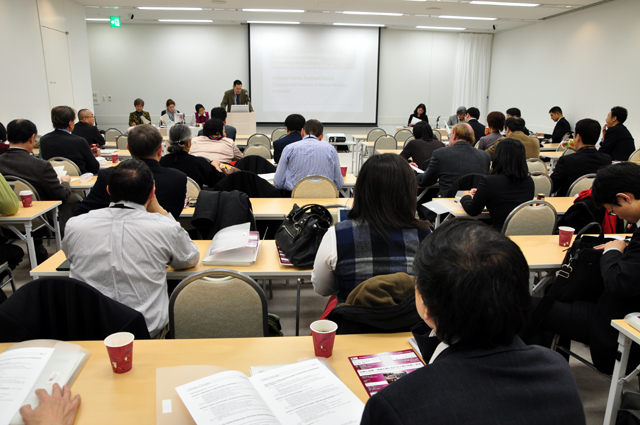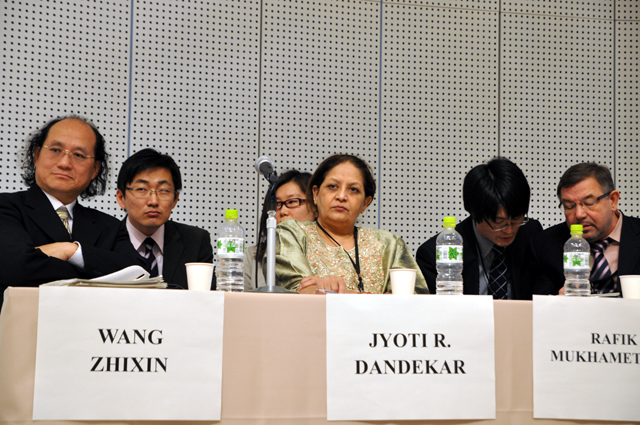|
[2010 Scientific Reseach on Innovative
Areas:]
The Fourth International Symposium
Regional Routes, Regional Roots? Cross-Border Patterns of Human
Mobility
in Eurasia
Report
by So Yamane
The fourth international symposium of Comparative Research on Major
Regional Powers in Eurasia in the Scientific Research on Innovative
Areas project was held over two days at the Osaka Breezé Plaza on
December 11 and 12. The symposium was organized by Group 5, which is
pursuing a project titled “The Contours of State and Border-Crossings”.
Under the theme of
“Regional Routes, Regional Roots?: Cross-Border Patterns of Human
Mobility in Eurasia,” this symposium aimed to shed light on the
character of major regional powers through discussion of minorities,
migrants, surrounding countries and other perspectives.
In the first
session, titled “Pilgrimage: Confession and Consumption,” Yoko Takayama
(Asia University) made use of numerous visual resources to explain how
the modern history of China as a “major power” has been legitimized,
and connected to consumption, through the use of commemorative items
connected with the Chinese revolution. This was followed by a
presentation by Eileen Kane (Connecticut College) on modes of support
for Muslim pilgrimages by Russia, a non-Islamic nation, at the start of
the 20th century. Employing rare propaganda materials, Kane explained
how the Muslim minority population was engaged by the Russian nation
and brought under its purview as a major power. Finally, using results
from a field survey on pilgrimages to Hindu sacred sites around the
city of Pune in Maharashtra State, Western India, Chihiro Koiso (Osaka
University) described the production of a Maharashtrian identity
through a distinctive set of local beliefs surrounding the Hindu deity
Ganesha.
In the second
session, “Home, Sweet Home? Invitation to the Diaspora,” Gulnara
Mendikulova (Center of Diaspora Studies, the World Association of the
Kazakhs) discussed the global distribution of Kazakh migrants, while
Surat Horachaikul (Chulalongkorn University) used his own experiences
as the basis for a presentation on the socio-economic conditions of
Indian migrants to Thailand. This was followed by a presentation by Liu
Hong (Nanyang Technological University), who reviewed the history of
Chinese diasporic populations since the 1950s, and then proceeded to
outline the phenomenon whereby overseas Chinese known as the “new
diaspora” return to China to work in the service of their mother
country.
Session 3 was
titled
“The Mobile Businessman: Merchants’ Diaspora and Networks.” In this
session, Artsvi Bakhchinyan (Institute of History, National Academy of
Sciences of the Republic of Armenia) reviewed the historical
development of Armenian merchant networks and their place in the
processes of formation of self-awareness among the Armenian people.
Stephen Dale (Ohio State University) discussed the history of South
Asian merchant networks by reference to two streams of expansion: into
the Safavid dynasty and other parts of West Asia, and into Southeast
Asia. Finally, Ryoichi Hisasue (The National Graduate Institute for
Policy Studies) provided a data-rich report on the connections between
Singaporean ethnic Chinese society and China itself, focusing
particularly on the banking business.
Day two opened
with
a special panel on “Proliferation of Knowledge: Fostering Elites and
Building the State Contours.” Wang Zhixin (St. Thomas University)
outlined the old civil service examination system in China and the
development of a bureaucratic class in the wake of the system’s
abolition, addressing both aspects of historical development and
current conditions and challenges. Jyoti R. Dandekar (Bharati
Vidyapeeth Deemed University) addressed the topic of inbound
international students in India, outlining educational conditions in
the country and the growth trend in inbound international student
numbers, in a presentation employing a fascinating set of photographs
and other resources. The third panellist, Rafik Mukhametshin (Russian
Islamic University), spoke about the current conditions and challenges
in Islamic education in Russia in the context of developing a Muslim
intellectual community. Issues covered in this presentation included
the discords arising between Middle Eastern Islamic educational
practices and the local conditions in Russia, a nation where many
different religions coexist.
The first speaker
in
session 4, titled “Cries from the Periphery,” was Michael Reynolds
(Princeton University), who described the strained relationship between
Kurdish communities and the Ottoman Empire in the early 20th century.
This was followed by Masato Toriya’s (Sophia University) historical
discussion of the tribulations of Afghanistan when caught in the
discord between Russia and British colonial India in the late 19th
century. The session was rounded out by Uradyn E. Bulag (University of
Cambridge) discussing human movement for political purposes in China in
the mid 20th century, as a window on Chinese Communist Party policy in
the formative years of the communist state.
The fifth session
was on “Gaining through Mobility: Migration and Settlement.” Jessica
Allina-Pisano and André Simonyi (University of Ottawa) joined the
session over an online conferencing system from Ottawa, Canada to
provide a comparative perspective on the inhabitants of borderlands by
reference to national borders between Europe and Ukraine, and between
Russia and China, using a collection of rare photographic images. Then
Sumie Nakatani (Kagoshima University) presented a discussion of the
unique merchant community of the Marwaris in India as seen through the
buildings and cities they created, while Cui Yanhu (Xinjiang Normal
University) reported on how the nomadic people of Xinjiang are altering
their spheres of movement within the framework of the Chinese state.
The symposium was
attended by 75 people on the first day, and 65 on the second. The
presentations were consistently thought-provoking, and enabled
consideration of alternative approaches to conceptualizing regional
powers. The discussion of differing fields and regions proved valuable
insights in expanding the perspectives of comparative research on the
contour formation of regional powers.
Link:
Symposium Program


[index]
|

